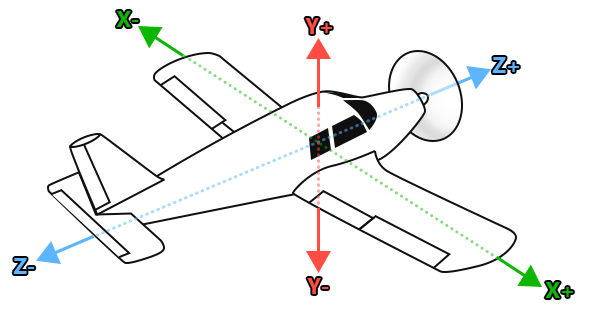Physics Objects Information
With Microsoft Flight Simulator 2024, each of the parts of an aircraft can be defined as specific physics objects permiting much greater control over their properties and their flight model behavior. This page contains various notes related to some of the functionality derived from the flight_model.cfg sections and parameters related specifically to these physics objects within the simulation (for example [OBJ_EA1_FUSELAGE.N] or [OBJ_AIRGEO_VTAIL]).
Note On Surface Cx
When it comes to defining the surfaces of your aircraft using the various [OBJ_EA1_*] and [OBJ_AIRGEO_*] sections of the flight model (for example [OBJ_EA1_FUSELAGE.N]), there are a number of parameters available which are used to create the lift and drag curves for the surfaces of the object being created. Each of these parameters have X (lateral), Y (vertical) and Z (longitudinal) components, since the surface can be positioned in 3D space, and the values used will be one or the other (or interpolated) depending on the position of the surface within the object definition. Note that these positions are all calculated relative to the Datum Reference Point. For example, if we consider a fuselage object:
- The X-axis (lateral, \(C_y\)) component defines how the surface will behave when on the sides of the fuselage.
- The Y-axis (vertical, \(C_n\)) component defines how the surface will behave when on the top and bottom of the fuselage.
- The Z-axis (longitudinal, \(C_a\)) component defines how the surface will behave when on the front and back of the fuselage.
- Any surface that is between these axis will use interpolated values, based on it's position.

The 4 different surface \(C_x\) values will use the appropriate component (X, Y, or Z) to calculate how the surface should react to the incoming airflow, depending on the position of the surface. These parameters are:
surface_cx- The friction - or drag coefficient - of the surface when the airflow / relative wind direction is close to the tangent to the surface. During normal flight, for the front facing surfaces of the fuselage, this parameter plays no role. For the side and top / bottom facing surfaces however, this will impact the global drag and sideforce of the aircraft when the aircraft slips or pitches up or down. For the top / bottom surfaces of the object, this also plays the role of the lift coefficient. In the case of the top-down surfaces of the fuselage, this describes the lift coefficient of the fuselage surfaces.
surface_cx_tangent- The friction - drag coefficient - when the airflow is at a perfect tangent to the surface. This is used to model imperfections on the surface, like old paint, scratches, etc... This parameter plays no role when the air is coming from a normal / perpendicular direction.
surface_cx_normal- The friction - or drag coefficient - of the surface when the airflow / relative wind direction is perpendicular to the surface. During normal flight, for the forward facing surfaces of the fuselage, this would be the drag coefficient. For the side-facing surfaces, this would be the drag coefficient when the airflow comes from the side, ie: when still on the ground or taxiing in a strong side wind. The same principle applies to wind coming from above or below the aircraft and hitting the top or bottom surfaces.
surface_cx_efficiency- this parameter works with thesurface_cxparameter. When the surface starts to have some incidence with the airflow, thesurface_cxapplies to lift but will also generate some drag. Thesurface_cx_efficiencyparameter allows you to define how much drag will be generated. This is the equivalent of induced drag for wings, but occurs for all surfaces of the aircraft with airflow coming from any direction.

Note On Physics Groups
Most of the available physics objects that can be created as part of the Microsoft Flight Simulator 2024 can be assigned to one or more groups. This is done through the group parameter (as listed in the object parameters for example: [OBJ_EA1_FUSELAGE.N]) of each object. By themselves, the group tags will have no direct impact on the simulation and are instead designed to be used in debugging and user-made tools. The built-in group tags are as follows:
The following debugging tools will use these groups as part of the way they gather debug information:
- The plane engine simulation measures propeller absorbed torque in the Engines debug window by looking at surfaces in the
bladegroup. - The helicopter engine simulation measures rotor absorbed torque in the Engines debug window by looking at surfaces in the
bladegroup. The main rotor and secondary/tail rotor are differentiated using thepNgroup, wherep0is the main rotor andp1is the secondary or tail rotor. - The plane propeller thrust force and moment debugging in the Engines debug window looks for surfaces with the
bladegroup. - For aircraft with surfaces that you want included in the data of the Sim Wind Tunnel debug window should be included in the group tag
extairframe. - To get debug data on helicopter rotor operations using the Engines debug window, you should include the following group tags:
root,typical,tip, andblade. - To include physics object surfaces in the Stall debug window data, use the
wing,tip,left,inner,right, andextairframegroup tags.
Groups And SimVars
The following SimVars will return information based on the groups assigned to the various surface objects:
WINDSHIELD WIND VELOCITY- This SimVar will derive it's value a surface that belongs to thefuselageandtipgroups. If there are no such surfaces available, it will use thecentergroup.
INCIDENCE ALPHA- This SimVar will return the angle of attack of different surfaces based on the supplied group ID value where:- 0 = the
centergroup - 1 = the surface objects that belongs to
wing,left, andtipgroups (ie: the left wing surface), or thecentergroup if there are no surfaces that meet the initial group criteria. - 2 = the surface objects that belongs to
wing,right, andtipgroups (ie: the right wing surface), or thecentergroup if there are no surfaces that meet the initial group criteria.
- 0 = the